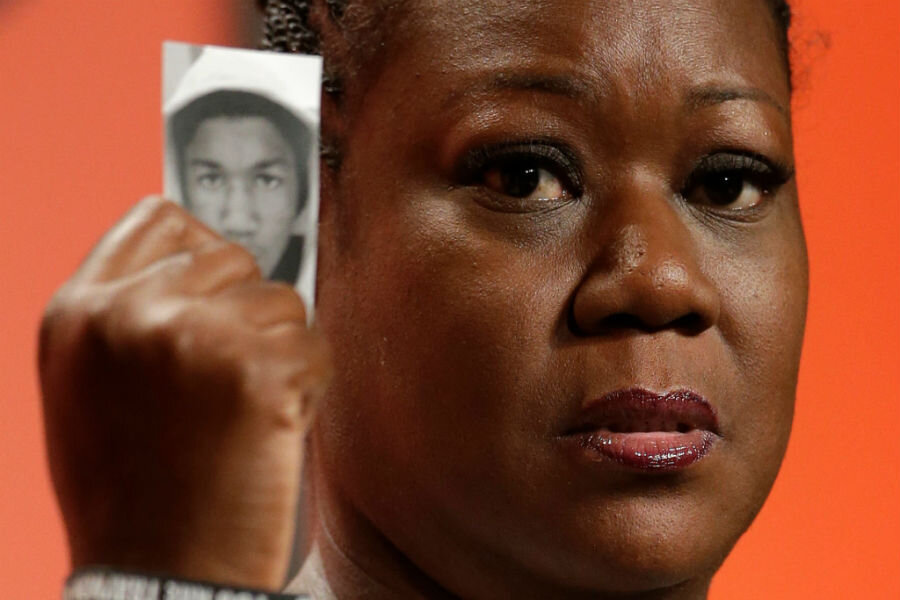Five years after Trayvon Martin’s death: What’s changed?
Loading...
Trayvon Martin would have been 22 years old this month, had he not been shot and killed by the head of the local neighborhood watch in Sanford, Fla., on Feb. 26, 2012.
In some ways, Trayvon's death was the spark for a civil rights movement that had lain dormant for decades, one that has shaken, not just the African-American community to which he belonged, but the nation as a whole. Today, five years later, Trayvon's death, along with other high-profile shootings of African-Americans at the hands of law enforcement, continues to amplify the grievances of a substantial portion of the black population.
The movement that began with a gut reaction to the tragic shooting, and subsequent acquittal of the shooter, has led to an important reconnection with uncomfortable racial issues that remained out of sight and out of mind for decades, says Wornie Reed, director of the Race and Social Policy Research Center at Virginia Tech, to The Christian Science Monitor via email.
"African-American racial justice movement activity stopped in the 1970s," says Dr. Reed, who knew Martin Luther King Jr. and was active in the civil rights movement during the 1960s. "From the mid-1970's we went four decades without such a movement – until the Black Lives Matter movement started in 2014, in reaction to the police killings of unarmed black men and boys."
The shooting of the unarmed black teenager sparked a massive public outcry. But when George Zimmerman was acquitted for the shooting at the subsequent trial for reasons of self-defense, the tag #BlackLivesMatter began to trend across social media, eventually coalescing into a coherent movement that hoped to shed light on the deep ethnic and racial divides that had quietly persisted in the United States for decades.
For Tracy Martin and Sybrina Fulton, Trayvon's parents, the death of their son had become more than a personal tragedy.
"All I wanted was to be a mother, to work at my job and raise my kids and live a normal life," Ms. Fulton writes in the book "Rest in Power: The Enduring Life of Trayvon Martin," which was released for the fifth anniversary of Trayvon's death. "Then my son was killed and my world went with him, and God led me to another place, another world and another life. I became a mother on a mission.... So that the killing of Trayvon Martin would stand for something, so that the killing will someday stop and the healing will begin."
After the acquittal of Zimmerman, community activists Alicia Garza, Opal Tometi, and Patrisse Cullors created the hashtag #BlackLivesMatter in protest.
"This generation of African-Americans grew to adulthood when there was little if any self-defining struggle," says Reed. "[But] struggles for civil and human rights are always needed," he adds. "Many of the rights and privileges African-Americans gained through the years were accomplished as the result of protests, public engagements, and demonstrations. Such activity had been largely missing since the 1970's. Racial progress stalled – and possibly regressed."
That stall suddenly came to an end, Reed says, as the deaths of Trayvon in Florida, Eric Garner in New York, Michael Brown in Missouri, and others, suddenly gained national notoriety, fueling the outrage of the movement's participants.
"#BlackLivesMatter is a call to action and a response to the virulent anti-Black racism that permeates our society," reads the description of BLM on their official website. "Black Lives Matter is a unique contribution that goes beyond extrajudicial killings of Black people by police and vigilantes."
Of course, the rise of BLM has not come without controversy. Conservatives have expressed concern that the movement effectively put a target on the backs of police officers leading to an increase in ambushes of law enforcement and fostering a general "state of lawlessness."
Opposition to the group sprang up almost immediately on social media, and the fledgling movement was even criticized by some African-Americans for its sometimes less-than-cohesive message and protest methods. Last year, however, BLM made efforts to clarify its various positions, creating a more streamlined set of principles and drawing up a new policy platform for the organization, as the Monitor previously reported.
"This happens to movements," Michael Fortner, a professor of urban studies at the City University of New York told the Monitor in August. "Over time people who are engaged in that activism realize that they have to take their movement to the next level, that they need to take their righteous indignation and turn it into good remedies for the problems they have identified, and I think this new Black Lives Matter platform tries to do just that."
Since its founding, BLM has inspired similar protests and brought increased scrutiny to racial biases on multiple levels of American society. It has also likely played a role in the push for police bodycams over the past few years, which supporters say hold officers accountable for their actions while on duty.
But despite this, BLM remains a divisive subject for many Americans. A Pew Research poll conducted between February and May of last year found that 43 percent of those surveyed said they support the movement. While only 22 percent said they opposed the movement, another 30 percent said they did not know about BLM, or chose not offer an opinion on the subject.
For Reed, the movement sparked by the death of Trayvon Martin still has a long way to go, but it has a great deal of potential for positive change, despite its tragic roots.
"Social movements often start with 'grass roots' people and end up affecting future societal developments," he says. "If the BLM movement continues and if it causes other movement organizations to form, it has the potential of affecting in a positive manner the near term history of the United States, especially in the area of racial justice."








